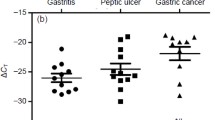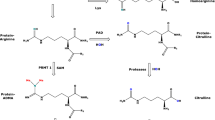Abstract
Innate and adaptive immune responses are activated in humans when Helicobacter pylori invades the gastric mucosa. Nitric oxide (NO) and reactive nitrogen species are important immune effectors, which can exert their functions through oxidation and S-nitrosylation of proteins. S-nitrosoglutathione and sodium nitroprus-side were used as NO donors and H. pylori cells were incubated with these compounds to analyze the inhibitory effect of NO. The suppressing effect of NO on H. pylori has been shown in vitro. Furthermore, the proteins modified by S-nitrosylation in H. pylori were identified through the biotin switch method in association with matrix-assisted laser desorption ionization/time-of-flight tandem mass spectrometry (MALDI-TOF-MS/MS). Five S-nitrosylated proteins identified were a chaperone and heat-shock protein (GroEL), alkyl hydroperoxide reductase (TsaA), urease alpha subunit (UreA), HP0721, and HP0129. Importantly, S-nitrosylation of TsaA and UreA were confirmed using purified recombinant proteins. Considering the importance of these enzymes in antioxidant defenses, adherence, and colonization, NO may exert its antibacterial actions by targeting enzymes through S-nitrosylation. Identification of protein S-nitrosylation may contribute to an understanding of the antibacterial actions of NO. Our findings provide an insight into potential targets for the development of novel therapeutic agents against H. pylori infection.
Similar content being viewed by others
References
Baker, L.M., A. Raudonikiene, P.S. Hoffman, and L.B. Poole. 2001. Essential thioredoxin-dependent peroxiredoxin system from Helicobacter pylori: genetic and kinetic characterization. J. Bacteriol. 183, 1961–1973.
Bennett, H.J. and I.S. Roberts. 2005. Identification of a new sialic acid-binding protein in Helicobacter pylori. FEMS. Immunol. Med. Microbiol. 44, 163–169.
Bryk, R., P. Griffin, and C. Nathan. 2000. Peroxynitrite reductase activity of bacterial peroxiredoxins. Nature 407, 211–215.
Choi, Y.W., S.A. Park, H.W. Lee, D.S. Kim, and N.G. Lee. 2008. Analysis of growth phase-dependent proteome profiles reveals differential regulation of mRNA and protein in Helicobacter pylori. Proteomics 8, 2665–2675.
Chuang, M.H., M.S. Wu, J.T. Lin, and S.H. Chiou. 2005. Proteomic analysis of proteins expressed by Helicobacter pylori under oxidative stress. Proteomics 5, 3895–3901.
Cole, S.P., V.F. Kharitonov, and D.G. Guiney. 1999. Effect of nitric oxide on Helicobacter pylori morphology. J. Infect. Dis. 180, 1713–1717.
Ellis, H.R. and L.B. Poole. 1997. Roles for the two cysteine residues of AhpC in catalysis of peroxide reduction by alkyl hydroperoxide reductase from Salmonella typhimurium. Biochemistry 36, 13349–13356.
Florio, W., G. Batoni, S. Esin, D. Bottai, G. Maisetta, F. Favilli, F.L. Brancatisano, and M. Campa. 2004. Influence of culture medium on the resistance and response of Mycobacterium bovis BCG to reactive nitrogen intermediates. Microbes Infect. 8, 434–441.
Forrester, M.T., M.W. Foster, M. Benhar, and J.S. Stamler. 2009. Detection of protein S-nitrosylation with the biotin-switch technique. Free Radic. Biol. Med. 46, 119–126.
Forrester, M.T., M.W. Foster, and J.S. Stamler. 2007. Assessment and application of the biotin switch technique for examining protein S-nitrosylation under conditions of pharmacologically induced oxidative stress. J. Biol. Chem. 282, 13977–13983.
Horwich, A.L., G.W. Farr, and W.A. Fenton. 2006. GroEL-GroESmediated protein folding. Chem. Rev. 106, 1917–1930.
Huang, B. and C. Chen. 2006. An ascorbate-dependent artifact that interferes with the interpretation of the biotin switch assay. Free Radic Biol. Med. 15, 562–567.
Jaffrey, S.R. and S.H. Snyder. 2001. The biotin switch method for the detection of S-nitrosylated proteins. Sci. STKE. 86, pl1.
Kim, N., D.L. Weeks, J.M. Shin, D.R. Scott, M.K. Young, and G. Sachs. 2002. Proteins released by Helicobacter pylori in vitro. J. Bacteriol. 184, 6155–6162.
Kuwahara, H., Y. Miyamoto, T. Akaike, T. Kubota, T. Sawa, S. Okamoto, and H. Maeda. 2000. Helicobacter pylori urease suppresses bactericidal activity of peroxynitrite via carbon dioxide production. Infect. Immun. 68, 4378–4383.
López-Sánchez, L.M., F.J. Corrales, M. De La Mata, J. Muntané, and A. Rodríguez-Ariza. 2008. Detection and proteomic identification of S-nitrosated proteins in human hepatocytes. Methods Enzymol. 440, 273–281.
Marikar, F.M., D. Ma, J. Ye, B. Tang, W. Zheng, J. Zhang, M. Lu, and Z. Hua. 2008. Expression of recombinant human FADD, preparation of its polyclonal antiserum and the application in immunoassays. Cell. Mol. Immunol. 5, 471–474.
Martin, P.R. and R.P. Hausinger. 1992. Site-directed mutagenesis of the active site cysteine in Klebsiella aerogenes urease. J. Biol. Chem. 267, 20024–20027.
Martínez-Ruiz, A. and S. Lamas. 2004. Detection and proteomic identification of S-nitrosylated proteins in endothelial cells. Arch. Biochem. Biophys. 423, 192–199.
McGee, D.J. and H.L. Mobley. 2000. Pathogenesis of Helicobacter pylori infection. Curr. Opin. Gastroenterol. 16, 24–31.
Nakamura, H., H. Yoshiyama, H. Takeuchi, T. Mizote, K. Okita, and T. Nakazawa. 1998. Urease plays an important role in the chemotactic motility of Helicobacter pylori in a viscous environment. Infect. Immun. 66, 4832–4837.
Nam, K.T., S.Y. Oh, B. Ahn, Y.B. Kim, D.D. Jang, K.H. Yang, K.B. Hahm, and D.Y. Kim. 2004. Decreased Helicobacter pylori associated gastric carcinogenesis in mice lacking inducible nitric oxide synthase. Gut 53, 1250–1255.
Persichini, T., M. Colasanti, G.M. Lauro, and P. Ascenzi. 1998. Cysteine nitrosylation inactivates the HIV-1 protease. Biochem. Biophys. Res. Commun. 250, 575–576.
Poole, R.K. 2005. Nitric oxide and nitrosative stress tolerance in bacteria. Biochem. Soc. Trans. 33, 176–180.
Qu, W., Y. Zhou, C. Shao, Y. Sun, Q. Zhang, C. Chen, and J. Jia. 2009. Helicobacter pylori protein response to nitric oxide stress. J. Microbiol. 47, 486–493.
Raupach, B. and S.H. Kaufmann. 2001. Immune responses to intracellular bacteria. Curr. Opin. Immunol. 13, 417–428.
Rhee, K.Y., H. Erdjument-Bromage, P. Tempst, and C.F. Nathan. 2005. S-nitroso proteome of Mycobacterium tuberculosis enzymes of intermediary metabolism and antioxidant defense. Proc. Natl. Acad. Sci. USA 102, 467–472.
Sabarth, N., S. Lamer, U. Zimny-Arndt, P.R. Jungblut, T.F. Meyer, and D. Bumann. 2002. Identification of surface proteins of Helicobacter pylori by selective biotinylation, affinity purification, and two-dimensional gel electrophoresis. J. Biol. Chem. 277, 27896–27902.
Salvati, L., M. Mattu, M. Colasanti, A. Scalone, G. Venturini, L. Gradoni, and P. Ascenzi. 2001. NO donors inhibit Leishmania infantum cysteine proteinase activity. Biochim. Biophys. Acta. 1545, 357–366.
Schapiro, J.M., S.J. Libby, and F.C. Fang. 2003. Inhibition of bacterial DNA replication by zinc mobilization during nitrosative stress. Proc. Natl. Acad. Sci. USA 100, 8496–8501.
Schröder, E. and C.P. Ponting. 1998. Evidence that peroxiredoxins are novel members of the thioredoxin fold superfamily. Protein Sci. 7, 2465–2468.
Scott, D.R., E.A. Marcus, D.L. Weeks, A. Lee, K. Melchers, and G. Sachs. 2000. Expression of the Helicobacter pylori ureI gene is required for acidic pH activation of cytoplasmic urease. Infect. Immun. 68, 470–477.
Seaver, L.C. and J.A. Imlay. 2001. Alkyl hydroperoxide reductase is the primary scavenger of endogenous hydrogen peroxide in Escherichia coli. J. Bacteriol. 183, 7173–7181.
Shao, C., Q. Zhang, W. Tang, W. Qu, Y. Zhou, Y. Sun, H. Yu, and J. Jia. 2008a. The changes of proteomes components of Helicobacter pylori in response to acid stress without urea. J. Microbiol. 46, 331–337.
Shao, C., Q. Zhang, Y. Sun, Z. Liu, J. Zeng, Y. Zhou, X. Yu, and J. Jia. 2008b. Helicobacter pylori protein response to human bile stress. J. Med. Microbiol. 57, 151–158.
Todd, M.J. and R.P. Hausinger. 1991. Identification of the essential cysteine residue in Klebsiella aerogenes urease. J. Biol. Chem. 266, 24327–24331.
Torta, F., V. Usuelli, A. Malgaroli, and A. Bachi. 2008. Proteomic analysis of protein S-nitrosylation. Proteomics 8, 4484–4494.
Tsuda, M., M. Karita, T. Mizote, M.G. Morshed, K. Okita, and T. Nakazawa. 1994. Essential role of Helicobacter pylori urease in gastric colonization: definite proof using a urease-negative mutant constructed by gene replacement. Eur. J. Gastroenterol. Hepatol. 6, S49–52.
Venturini, G., M. Colasanti, L. Salvati, L. Gradoni, and P. Ascenzi. 2000. Nitric oxide inhibits falcipain, the Plasmodium falciparum trophozoite cysteine protease. Biochem. Biophys. Res. Commun. 267, 190–193.
Voland, P., D.L. Weeks, D. Vaira, C. Prinz, and G. Sachs. 2002. Specific identification of three low molecular weight membraneassociated antigens of Helicobacter pylori. Aliment. Pharmacol. Ther. 16, 533–544.
Zaki, M.H., T. Akuta, and T. Akaike. 2005. Nitric oxide-induced nitrative stress involved in microbial pathogenesis. J. Pharmacol. Sci. 98, 117–129.
Zhang, L., S.B. Mulrooney, A.F. Leung, Y. Zeng, B.B. Ko, R.P. Hausinger, and H. Sun. 2006. Inhibition of urease by bismuth (III): implications for the mechanism of action of bismuth drugs. Biometals 19, 503–511.
Author information
Authors and Affiliations
Corresponding authors
Rights and permissions
About this article
Cite this article
Qu, W., Zhou, Y., Sun, Y. et al. Identification of S-nitrosylation of proteins of Helicobacter pylori in response to nitric oxide stress. J Microbiol. 49, 251–256 (2011). https://doi.org/10.1007/s12275-011-0262-7
Received:
Accepted:
Published:
Issue Date:
DOI: https://doi.org/10.1007/s12275-011-0262-7




